Archive for the ‘Lady of the Night Orchid’ Tag

The transition from the wet into the dry season is normally marked by a variety of changes that are both easy to see and hear. So far those changes have not been that obvious for 2017. The unusually heavy rains during November and December last year would appear to have delayed, if not completely altered a lot of plant and animal behaviors. But now, some two months after expecting to see certain changes, they are beginning to take place.
There has been a late start to the flowering season for many trees. This week some of the trees that would have been expected to flower in December are now flowering in February. One notable example is the Ajo Tree, (Caryocar costarincensis). Its bright lemon yellow blooms can now be seen littering the forest floor on many of the trails. Take a trip up into the tree tops on the canopy platform and you will find many species of tree crowns covered in flowers. This is turn attracts many butterflies and they can be seen flying from flower to flower, tree to tree, all around the sunlit forest canopy.

Ajo Tree, (Caryocar costaricensis). Flowers.
Rain forests in general can be windless areas. The forests of the Osa Peninsula experience very little wind except when a heavy rain approaches pushing a pocket of air in front of it. The plants therefore have to rely for the most part on animals to carry out both pollination and seed dispersal. Bats are very important pollinators and seed dispersers. Bats prefer musky odors to sweet odors. This results in the plants emitting various scents that humans would not be expecting, being used to the more fragrant sweet smell of flowers. The bats however are attracted by the scent of garlic. The nectar feeding bats have a long muzzle and a long sticky tongue. While they are feeding on the nectar, the long anthers of the flower dust pollen over the head and shoulders of the bat which then flies off to visit another flower transferring the pollen and effecting pollination.
In subtle contrast to the green of the hedgerow vegetation are the strong purples of the Morning Glory, (Ipomea) which are currently flowering. This is a vine which wends its way through the hedges. The purple color is attractive to insects. The flowers prefer the full sun despite the name “Morning Glory” which refers to the flowers unfurling at first light of dawn.

Morning Glory, (Ipomoea sp)
The butterflies are starting to be seen in greater numbers but the levels fall a long way short of what would be expected at this time of year. The height of the butterfly season is between February and March but so far the visible populations, particularly of some species, are noticeably down.
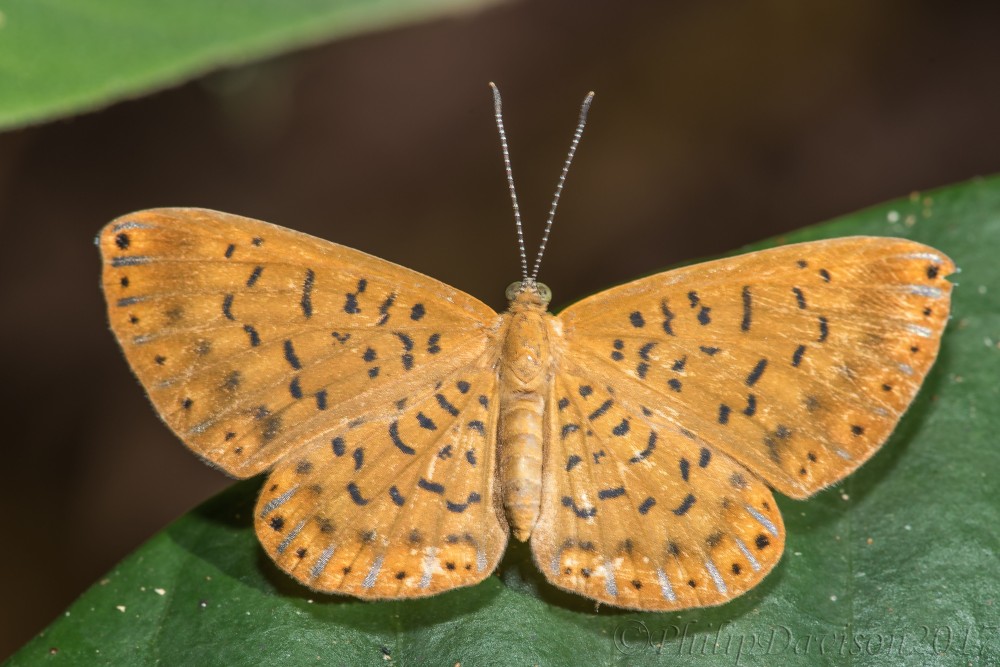
Metacharis victrix
At night the number of amphibians is starting to diminish. For some time now the number of species has reduced to 4 or 5 but the number of individuals of each species has dwindled to only one or two hopeful males calling for a mate. It is highly unlikely that there will be a response at this time of year. The Savage’s Thin-fingered Frogs, (Leptodactylus savagei), are increasing slightly in numbers around the pond. As the area continues to dry the pond is the only damp refuge and these large amphibians start to congregate around the pond edge sometimes entering the water where they can be found floating.
Floral Descent
Whereas many of the plants have been slow to flower, some of the orchids have not.. To see the orchids you generally need to up in the forest canopy, 88% of the Costa Rican orchids are epiphytic, they are up at the top of the trees. But occasionally you may be lucky to see some that have found a suitable location nearer to the ground. When not in bloom it is easy to miss them as many orchids have small insignificant flowers, but not all, others when in flower can have quite a showy display. Orchidaceae is a very species rich family of flowering plants rivalled only by the Asteraceae or daisy family in terms of numbers. Being so diverse makes them hard to identify. Many people admire them for their aesthetic, if sometimes subtle, beauty. They are therefore a group of greater interest to orchid specialists in terms of identification and geographical distribution. Equaled by the diversity of species and form of the flowers are the number of ways in which orchids become pollinated. Some of them have evolved means of attracting pollinators that would seem to be, on first reading, the stuff purely of science fiction.
Around the gardens and forests there are orchids that are slightly more obvious. Growing on some of the garden trees as epiphytes are the white-flowered, night-perfumed Lady of the Night, (Brassavola nodosa). At night the white flowers give off a heavy sweet perfume that attracts in hawkmoths. The moths hover in front of the flower and using the long proboscis probe for nectar. While doing so they become covered in pollen which is then transferred to the next flower they visit. Not too far away growing in the borders are the Bamboo Orchids, (Arundina graminifolia). This is a terrestrial orchid native to south east Asia. It is however widely grown in Costa Rican gardens. The purple bee pollinated blooms are born on long thin stems that resemble a bamboo stem.
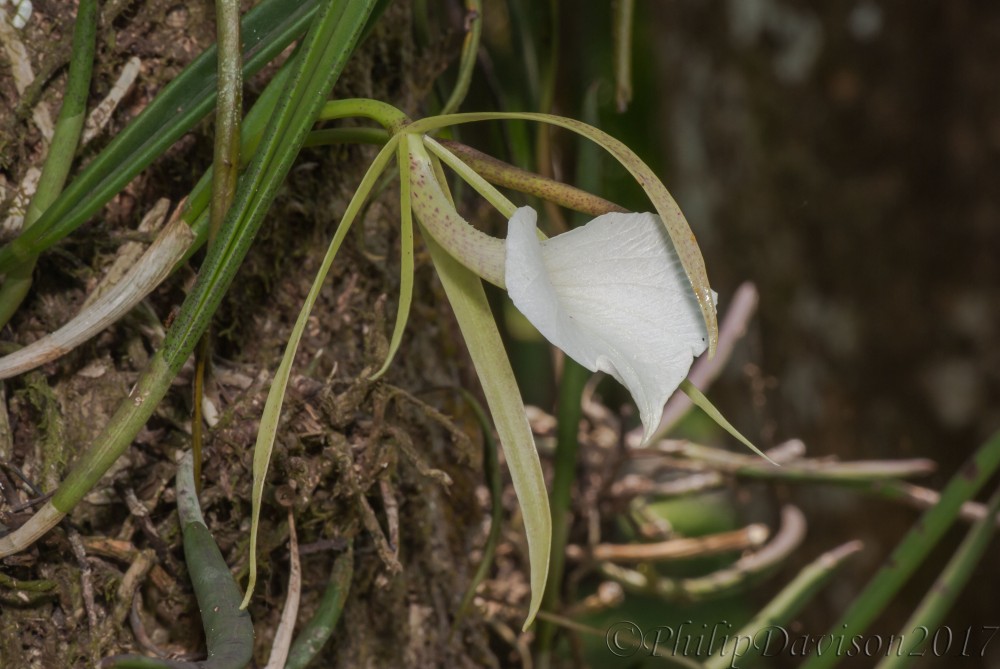
Lady of the Night, (Brassavola nodosa)
On the forest trails growing low down and in locations near to water you may find, (Stanhopea cirrhata). Stanhopea species emit an scent that attracts certain species of orchid bee. The males gather the scent which they mix with other plant volatiles to produce their own perfumes. The structure of the Stanhopea orchid is such that while the bee is gathering the scent a pollen package is attached to the bee which unwittingly transfers it to the next orchid it visits.
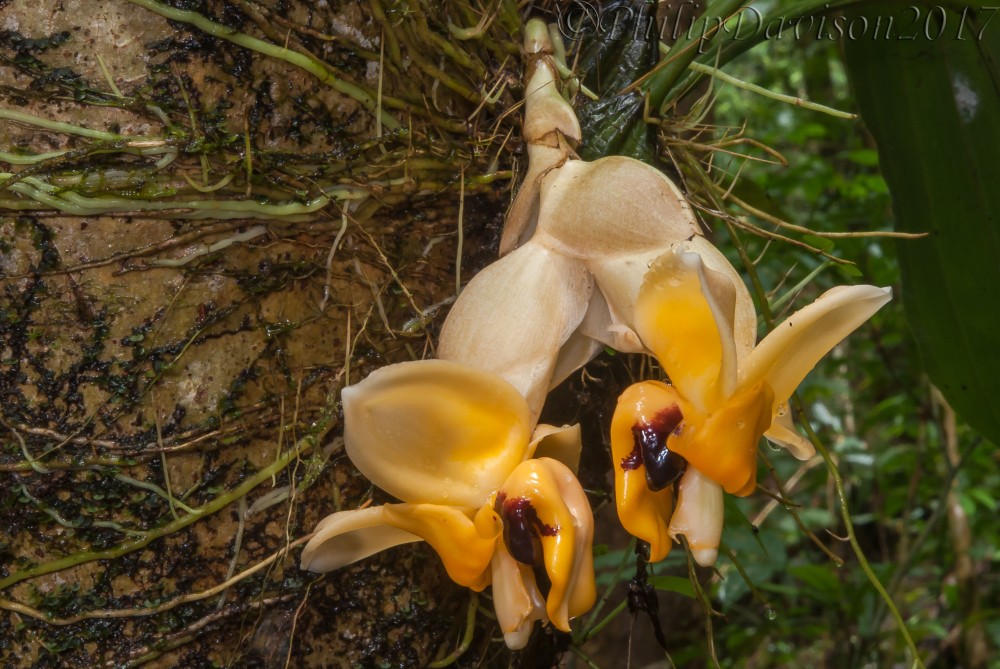
Stanhopea cirrhata
There are some orchids whose flowers are as green as their leaves. Numbering amongst them is the Vanilla Orchid, (Vanilla planifolia). In the wild Vanilla orchids are pollinated by orchid bees but when commercially grown and pollinated by hand. Growing on the sides of trees are some of the green flowered Epidendrum Orchids. There are about 160 species of Epidendrum in Costa Rica which makes them a little difficult to identify.
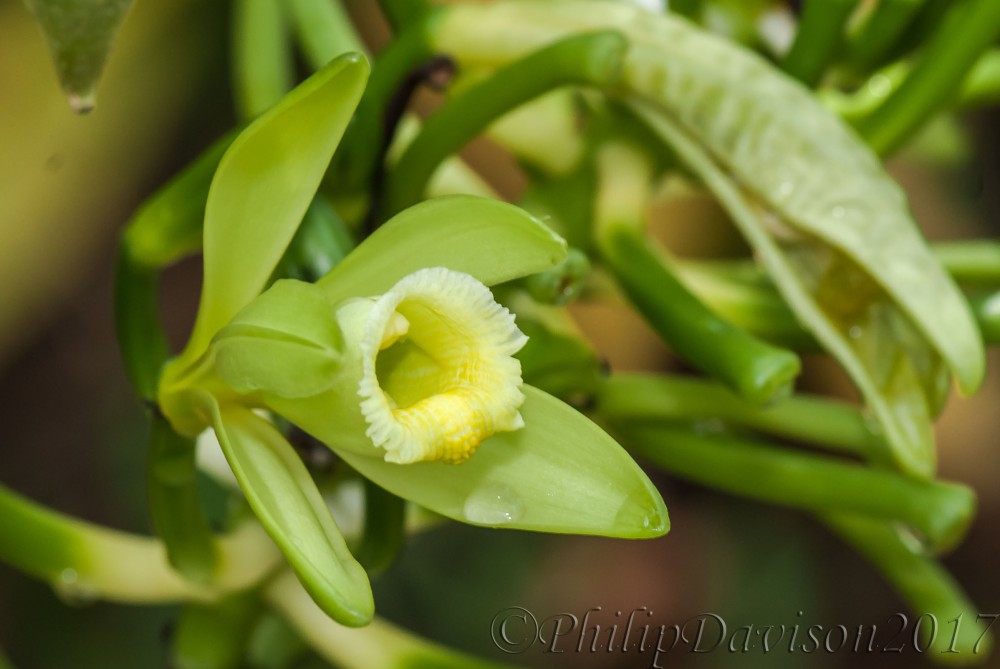
Vanilla Orchid, (Vanilla planifolia)
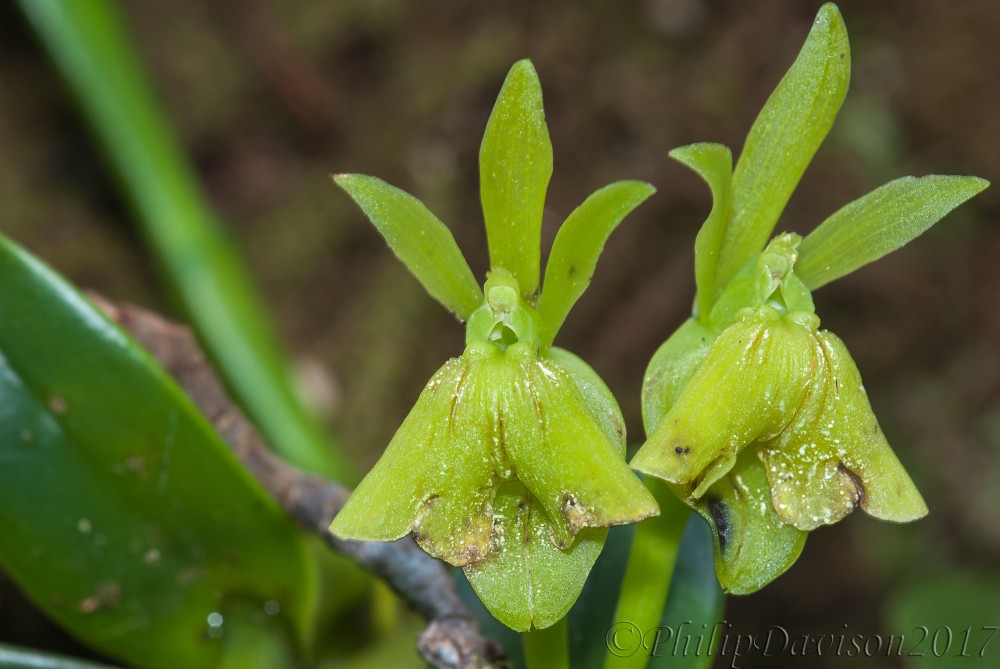
Epidendrum sp
Dragons and Damsels
If you spend enough time by any body of water around the grounds then you are likely to see some of the Odonates; dragonflies and damselflies. The dragonflies can more commonly be found still bodies of water such as the pond whereas the damselflies seem to frequent areas closer to running water such as the creek. They can also be seen in the gardens and throughout the forest too. You can tell a dragon from a damsel when they land as the dragonflies perch with the wings out to the sides whereas the damselflies perch with the wings folded together over the back.
You have to have patience to photograph dragon and damselflies. They react to the slightest movement near them by taking to the air. They do have favored perches though so if you set the camera up on a tripod or simply rest in a comfortable position, camera in hand, they well almost always return in short time and alight at the place from which they took off.
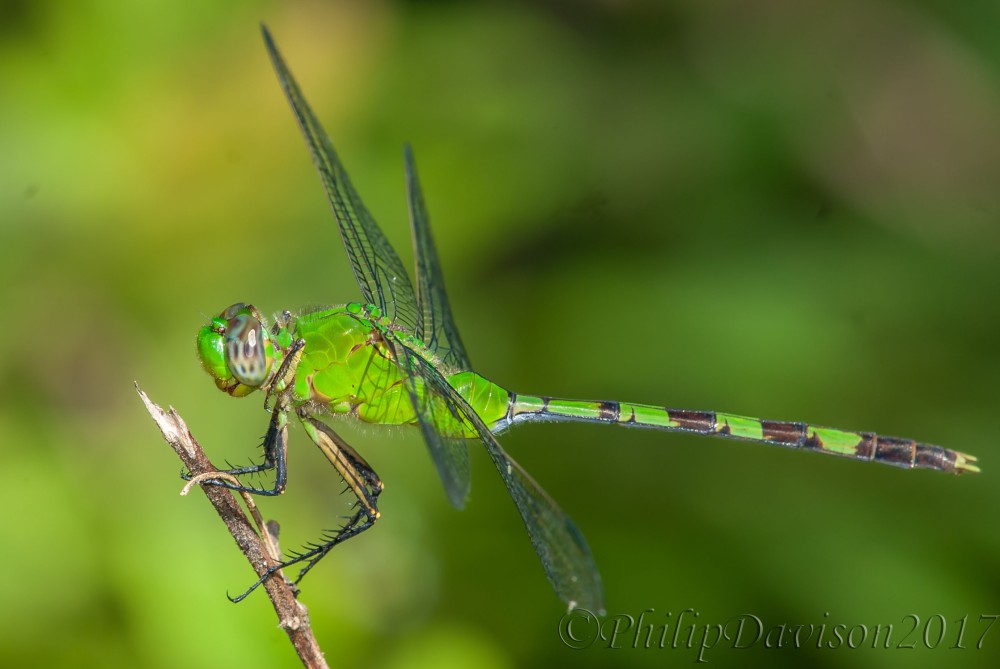
Great Pondhawk, (Erythemis vesiculosa)

Red-mantled Dragonlet, (Erythrodiplax fervida)
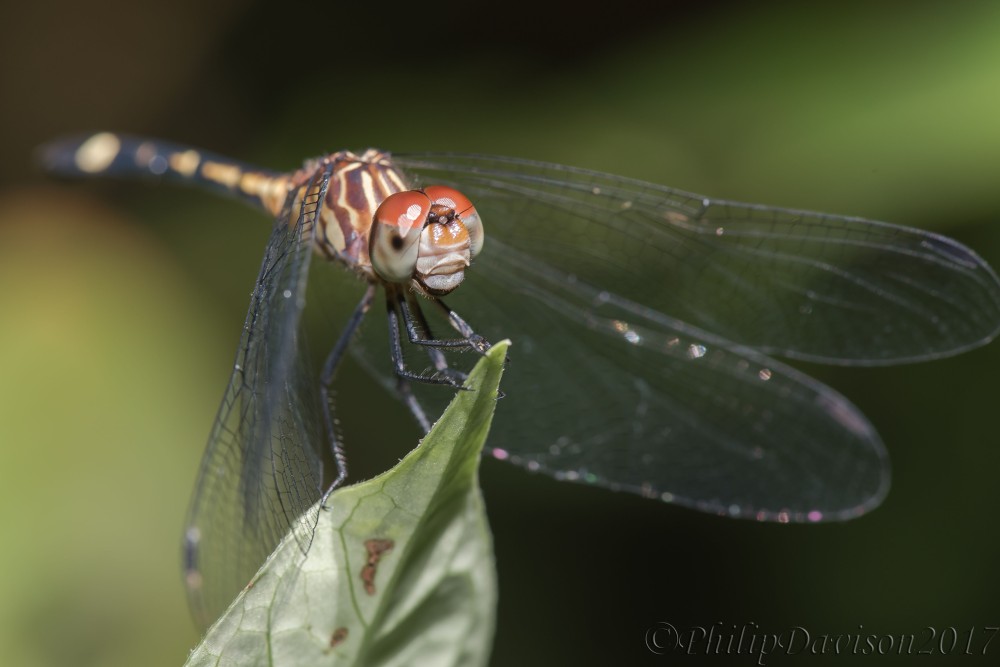
Three-striped Dasher, (Micrathyria didyma)
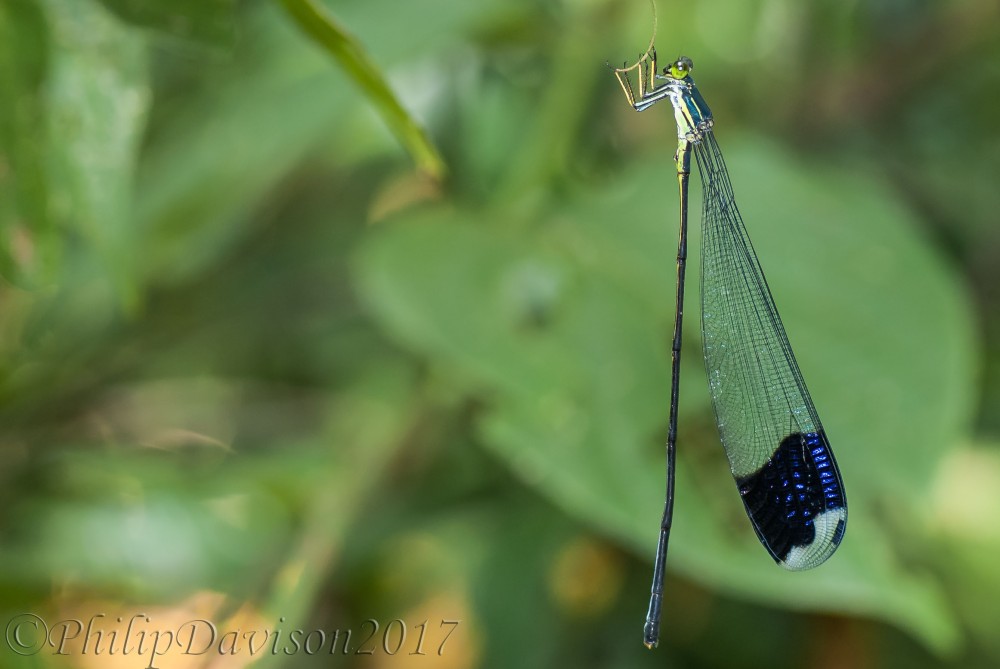
Helicopter Damselfly, (Megaloprepus caerulatus)
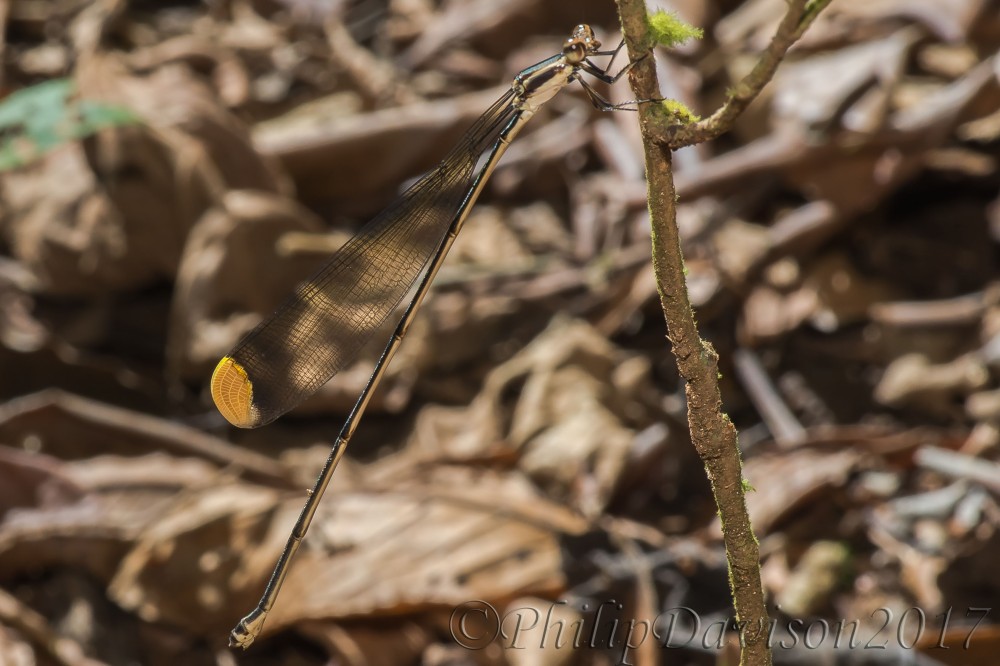
Ornate Helicopter Damselfly, (Mecisogaster ornata)
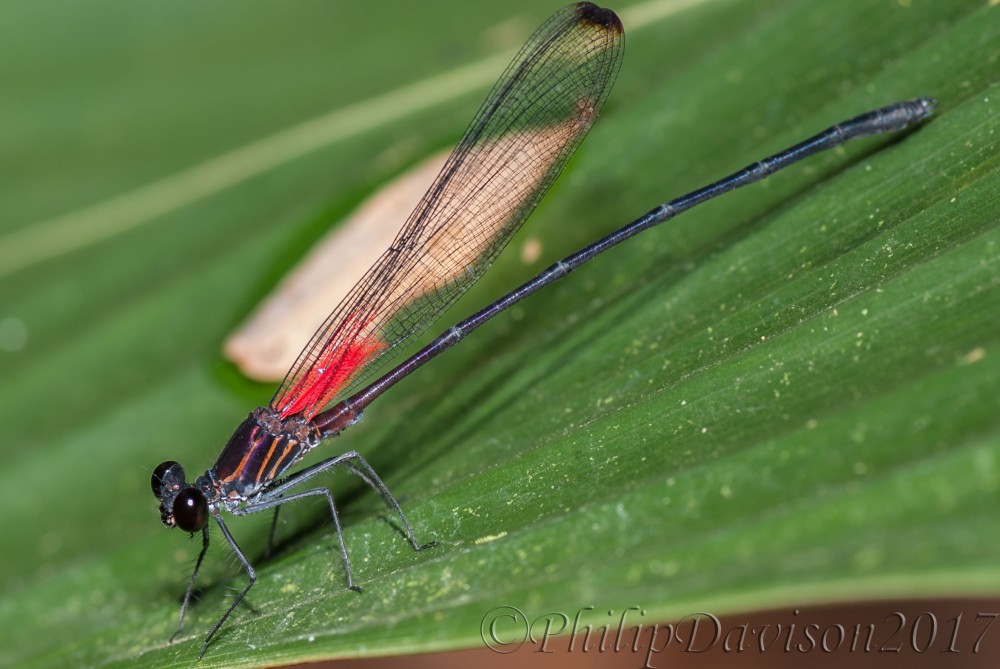
Hetaerina orissa
Philip Davison is a Biologist, Writer and Photographer Based in Costa Rica
Felipe del Bosque Blog Nov 28th 2011

Coming to the End
This week started with a difference to last week. There was a little light drizzle in the morning but the sun managed to break through in the afternoon. Then, the wet season ended, albeit stutteringly. We have had lots of sun, little rain and increasing temperatures.
Significantly, the butterflies responded by appearing in greater numbers. First there were several individuals of a few species but as the sun shone for longer hours and the temperatures went up so did the number of butterfly species and subsequently the number of individuals.
It has not stopped raining entirely though. Throughout the week there have been periods of light rain, sometimes in the evening and sometimes in the morning but enough to say we are now in that transitional period between wet and dry.
As You Were
There has not been anything out of the ordinary happening this week in terms of wildlife. The migrants are with us until next March or April and the residents are here in normal numbers. On one of the night tours this week we were graced by the presence of a Crested Owl, (Lophostrix cristata), which sat and looked at us from a good vantage point, both for it and for us.
The visitors were also lucky enough to see a large female Parachuting Red-eyed Green Tree Frog, (Agalychnis spurelli), down by the pond. They are normally found once or twice a year in huge numbers following torrential rain but this was a lone individual that had made its way down from the top of the trees.
I did happen to find a Rough-skinned Rain Frog, (Craugastor rugosus), with a different skin pattern to that which I am accustomed to seeing that I managed to photograph.

The Laughing Falcon, (Herpetotheres cachinnans), has been making itself heard if not seen over the past couple of days. The call is that seemingly never ending “He Haw, He Haw” which becomes slower in tempo the longer it continues.
Philip is a biologist, writer and photographer as well as the onsite naturalist guide at Bosque del Cabo Rainforest lodge on the Osa Peninsula, Costa Rica.
www.bosquedelcabo.com
Photo Feature
One morning when I went over to the restaurant I found a large moth resting on the wooden rail surrounding the deck. The characteristic shape of its wings gave away its identity immediately as one of the Hawk or Sphinx Moths, (Sphingidae). The wings of all sphinx moths tend to be long and narrow with an almost triangular form to them. In color they can be gaudy or subtle. This individual had the more cryptically blended shades of grey.

Sphinx moths are very important pollinators of many plants in the forest. Just like nectar feeding bats which serve as effective pollinators, the plants that they visit have evolved flowers that specifically select to attract the moths. Nectar feeding bats have a long tongue with a bristly tip to soak up nectar, the sphinx moths have a long proboscis and have the ability to do what hummingbirds do, they can hover. While both bat and moth pollinated flowers tend to be long and tubular, down into which the tongue or proboscis extends, the difference lies in the way that they are lured to the plant. Bats prefer musky scents while moths are attracted to sweet scents. Unlike hummingbirds which visit flowers during the day, the bats and moths are nocturnal and so plants pollinated by these agents issue their odors once the sun has set. A sphinx moth pollinated plant commonly found around the grounds of Bosque del Cabo is the Lady of the Night Orchid, (Brassavola nodosa). It has a long, white, trumpet shaped flower and gives off a sweet perfume just after dusk.

The name sphinx moth refers to the habits of the caterpillars which can grow to a large size. When disturbed, perhaps by a potential predator, the caterpillar lifts up the front end with the head tucked down and appears, at least to our eyes, to resemble the Egyptian Sphinx. To the predator it probably increases the apparent size of the caterpillar which also sports at the rear end a long fleshy spine which could give the appearance of a lethal stinging organ.

Due to limited reference material, which is the bane of my life in trying to identify many of the creatures I find here, I think, but would stand to be corrected, that this particular moth is Madoryx plutonius.
Text and Photographs are taken from the forthcoming book:
The Natural History of Bosque del Cabo by Philip Davison
Temperature and Rainfall
Average Daily Temp High 83°F. Average Daily Temp Low 72°F.
Average Daily Rainfall 0.17 ins. Total Weekly Rainfall 1.21 ins
Average Daily Temp High 27.8°C. Average Daily Temp Low 22.3°C.
Average Daily Rainfall 4.4 mm. Total Weekly Rainfall 30.7 mm
Species List for the Week
Mammals
- Howler Monkey
- Spider Monkey
- White-faced Monkey
- White-nosed Coati
- Agouti
- Collared Peccary
Birds
- Orange-chinned Parakeets
- Red-lored Amazon
- Gray-necked Woodrail
- Lineated Woodpecker
- Pale-billed Woodpecker
- Bat Falcon
- Roadside Hawk
- Laughing Falcon
- White Hawk
- Black-hooded Antshrike
- Chestnut-backed Antbird
- Wedge-billed Woodcreeper
- Short-billed Pigeon
- White-tipped Dove
- Long-billed Hermit
- Rufus-tailed Hummingbird
- Common Paureque
- Crested Owl
- Spectacled Owl
- Mangrove Swallow
- White-collared Swifts
- Chestnut-mandibled Toucan
- Red-capped Manakin
- Golden-hooded Tanager
- Summer Tanager
- Alder Flycatcher
- Bright-rumped Atilla
- Dusky-capped Flycatcher
- Great Kiskadee
- Tropical Kingbird
- Tennessee Warbler
- Black-throated Trogon
- House Wren
- Riverside Wren
- Masked Tityra
- Rufus Piha
- Great Tinamou
- Black Vulture
- Turkey Vulture
Reptiles
- Common Basilisk
- Cat-eyed Snake
- Central American Smooth Gecko
- Clawless Gecko
- Barred Ameiva
- Four-lined Ameiva
- Golfo Dulce Anolis
- Mediterranean House Gecko
- Terciopelo
Amphibians
- Marine Toad
- Parachuting Red-eyed Green Tree Frog
- Red-eyed Green Tree Frog
- Black and Green Poison Arrow Frog
- Fitzinger’s Rain Frog
- Rough-skinned Dirt Frog
- Tink Frog
Butterflies
- Anartia Fatima
- Glutophrissa drusilla
- Heliconius cydno
- Heliconius erato
- Heliconius ismenius
- Heliconius sapho
- Hermeuptychia hermes
- Morpho helenor
- Morpho menelaus
- Opsiphanes tamarindi
Plants
- Bamboo Orchid Flowering
- Black Alligator Tree Fruiting
- Calabash flowering and fruiting
- Cannonball Tree Flowering and Fruiting
- Clusia rosea Flowering
- Golden Trumpet Vine Flowering
- Inga Flowering
- Monkey Comb Tree Flowering
- Figs Fruiting
- Mountain Rose Flowering
- Ox Eye Vine Fruit
- Stinky Toe Fruiting
8.565093
-83.511169
Felipe del Bosque Blog April 2011 Review

The high temperatures experienced in February and March continued into April. This year the rains came a little earlier than would normally be expected. On one or two occasions we had torrential thunderstorms occurring overnight this month. The heavy rain caused some very large trees to fall. One large Monkey Comb tree fell not too far from the suspension bridge. Even though the rain was lashing down so heavily it was hard to hear anything outside your immediate vicinity, everyone standing in the bar heard that particular crash.
In response to the first rains for 4 months, the amphibians were stimulated into action. Huge breeding aggregations of Milky Frogs, (Trachycephalus venulosus), filled the ponds with a choral cacophony of amorous males, each calling for a mate with such voluminous gusto, that their collective sound could quite easily be heard by guests taking their evening meal in the lodge restaurant.


Although the Milky Frogs were the most numerous and vociferous of the pond inhabitants, there were other frogs too vying with them for some breeding space. We had our first sightings for the impending wet season of the Banana Frogs, (Dendropsophus ebreccatus) and the Masked Smilisca, (Smilisca phaeota).


There are many orchids around the grounds of Bosque, unfortunately most of them growing up at canopy level, but there is one species which grows closer to the ground. Lady of the Night, (Brassavola nodosa), can be found growing in clumps on several trees close to the restaurant. Once or twice a year it produces long white trumpet shaped flowers that give off a sweet perfume once the sun has set. The scent attracts in night flying hawk moths with long proboscises that can be inserted into the deep into the flower searching for the sugary nectar.

In comparison, one of the trees on which we find the orchid growing is the Calabash Tree, (Cresentia alata), which flowers and fruits all year round. Also in contrast to the orchid, the Calabash is a bat pollinated tree and consequently has large pale colored, night flowering blossoms that emits the bat attracting scent of sweaty cheese.

Paper Wasps can be identified to species level by the form the wasp’s nest takes. In general wasps in the genus Polistes have open nests while those in the genus Polybia have enclosed nests. This nest I found under a leaf with only one female in attendance, probably the dominant reproductive female whose close relatives and nest mates may have been away foraging for food. You can see eggs and larvae in the open cells while one closed cell contains a pupa.

Over the course of the year the numbers of butterflies fluctuates greatly. Some butterfly species you expect to see almost every day of the butterfly season but others you only see once or twice. It may well be that they exist in small numbers or they may be secretive or they may inhabit areas such as the canopy where it is difficult to record them without resorting to bait trapping. Even that may not work as not all butterflies are attracted to the bait. This particular species, (Callicore lyca), of the Biblidinae subfamily I see only on one or two occasions a year. This individual was on the Titi Trail and I could never get close to it, the image being captured from some distance using a 100mm macro lens.

That same lens was used to capture this White Hawk, (Leucopternis albicollis), which landed above my head in one the open garden areas. White Hawks can generally be found in the company of moving troops of monkeys. They have no interest in the monkeys themselves, it is the insect life that the monkeys scatter as they move through the vegetation that make an easily picked off meal for this beautiful raptor.

Text and Photographs are taken from the forthcoming books:
The Natural History of Bosque del Cabo by Philip Davison
The Small World of Bosque del Cabo
The Colors of Bosque del Cabo
A Children’s Guide to Bosque del Cabo Rainforest Lodge
Temperature and Rainfall
Average M Temp High 94°F. Average Daily Temp Low 74°F.
Average Daily Rainfall 0.04 ins. Total Monthly Rainfall 1.28 ins
Average Daily Temp High 34.3°C. Average Daily Temp Low 23.0°C.
Average Daily Rainfall 1.0 mm. Total Monthly Rainfall 32.5 mm
8.565093
-83.511169




























